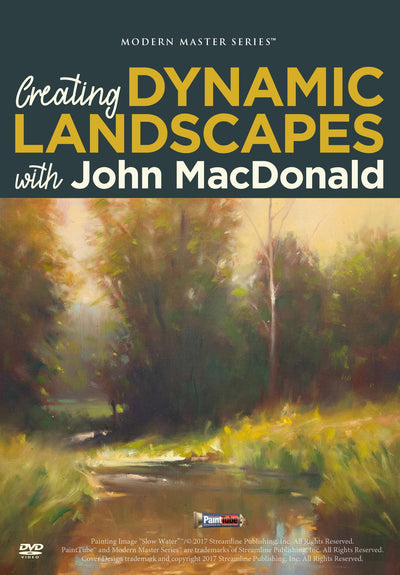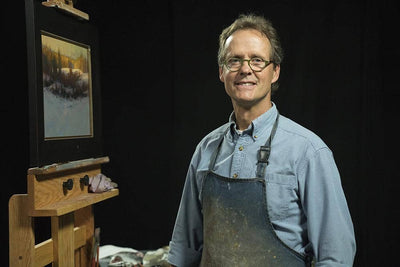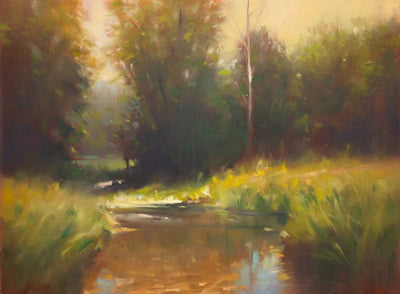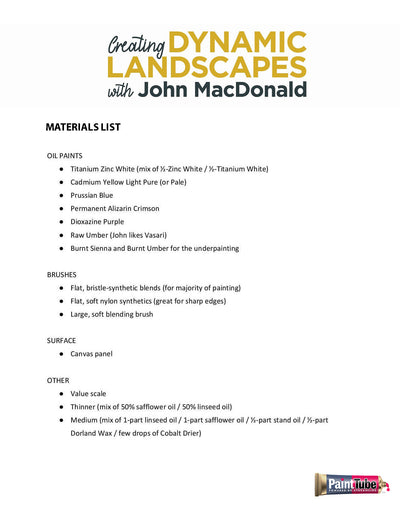Your Cart is Empty
FREE U.S. DOMESTIC SHIPPING • 100% MONEY-BACK GUARANTEE • Lifetime Access • No Subscription
FREE U.S. DOMESTIC SHIPPING • 100% MONEY-BACK GUARANTEE • Lifetime Access • No Subscription




$199.04 $157.97
You Save 20% ($41.07) 
Paintings … when done well … create an emotional response.
The goal of a painter should be to create a landscape painting that transports the viewer into the scene, where it evokes deep feelings and emotions.
If you paint a snow scene, your viewer should shiver.
A beach scene should let the viewer feel the warmth of the sun, and hear the seagulls.
To paint emotional landscapes, it’s important to study with a master landscape artist who has conquered the nuances of light, the energy of the foliage, and the perfect balance of color — to create an atmosphere where you can tell the temperature just by looking at the scene.
Few painters actually possess these skills, and fewer can teach them.
There is one artist who is a painter’s painter, someone other top artists seek out to take their own paintings to a higher level.
Nowhere will you find that sort of master instruction but with John MacDonald, one of the most successful and prominent artists in North America, and one of the world's great teachers.
John MacDonald is careful to emphasize that there are no secrets or shortcuts provided in this course. Instead, John will offer a fresh approach ... by giving you a deeper understanding of the entire process to create an important and visually stunning work.
John lays out the painting process in three steps:
Concepts you can understand on an intellectual level
Demonstrations so you can see the concepts take form in practice
Participation, because the only way you will learn to paint is to paint
You’ll discover incredible insights that are the keys to mastering any art form. For instance, it’s the value, not the color, that creates the illusion of space, light, and form in a painting; color contrast works only when colors are similar in value; and it’s crucial to see (and paint) shapes, not things.
Don’t be misled. While this course focuses on the basic elements of painting, and beginners will certainly benefit, each element is covered in such depth that even experienced painters will learn from it. In fact, many of the world’s leading artists seek out instruction from John to help them elevate their paintings to a higher lever.
Any visual artist, regardless of medium or subject matter, can benefit from an in-depth examination of the principles of painting, such as...
Changing your view to acknowledge that every painting is a brand-new invention, a construction, not a copy of what you are seeing
The hierarchy of importance among the elements in your painting
Why creating the composition and value structure are the most important components of your piece, and how to create them properly
How variety and contrast in shapes, values, colors, edges, and details are hallmarks of successful paintings
Methods to distinguish the important parts you can and should capture in a painting when faced with visual overload
You’ll find the insights in this video incredibly unique...
John MacDonald is a painter’s painter, and one who will elevate your overall skills by demonstrating these important principles and showing how to make sublime, emotionally appealing paintings.
“A landscape truly seen takes us out of ourselves, reminding us of the brevity of, and our interconnection to, all of life.”
— John MacDonald
A Significant Shortage of Secrets & Shortcuts
While many of our art courses provide you with insights into the minds of great artists, or unique tools you can use to achieve amazing results. Creating Dynamic Landscapes takes a completely different approach by putting the emphasis on the basic elements of painting and helping artists come to a deeper understanding of the process to create an important and visually stunning work.
Create Your Personal Painting Process
MacDonald clearly states early on that this is his process. He cautions viewers to use what works for them and ignore the rest. But as he unpacks each step and walks you through, you’ll discover a process for creating incredibly powerful masterpieces, including:
You’ll see how John MacDonald’s process is universally transferable, to any creation.
And, in addition to subjective topics such as personal process, MacDonald provides several practical points, such as how to create color harmony easily and how to set up a non-toxic studio.
Further, he’ll provide information that can improve any process, including why you shouldn’t rush back to the studio to paint what you’ve seen, and how to use your computer as an aid to help make your paintings capture the memory of the scene, mood, and feeling.
Learn to Love Landscape Painting (and Beyond!)
No matter what level or type of artist you are, the benefits you can glean from John MacDonald’s deep dive into process are invaluable. While there are numerous lessons that examine specific materials and teach little-known techniques, few explore in such depth the very essentials of painting. Any artist will come to a greater appreciation for and understanding of what makes for a successful painting. Although based in the fundamentals, MacDonald provides tips around subjects even the most expert painters can appreciate, including:
Including an Inspirational Interview
To supplement John MacDonald’s engaging five-hour demonstration, you’ll get a lengthy interview with the artist himself and gain invaluable insights into how he works and why he focuses so much on the process, rather than the result. You’ll discover why his subject of choice is landscape, where his inspirations come from, and what it takes to transport a viewer from looking at your painting to experiencing your painting.
Don’t miss this amazing opportunity to explore the fundamentals of landscapes and discover the essence of the process of painting from a true master.
About Your Instructor
John MacDonald attended Washington University in St. Louis, where he received a BFA in 1979. Following college, he attended a four-month intensive printmaking workshop at the Institute for American Universities in Avignon, France. Returning to the States, he received an MA degree in drawing and painting from Purdue University in 1982. For nearly 30 years, John worked as both a freelance illustrator and landscape painter. He has won awards from Print Magazine and had his work appear in the Society of Illustrators annual show. He now paints full-time. His paintings are held in private and corporate collections throughout North America. His professional memberships have included the Creativity Coaching Association, the Society of Illustrators, the Illustrators Partnership of America, the National Association of Plein Air Painters, the Graphic Artists Guild, and the Oil Painters of America.